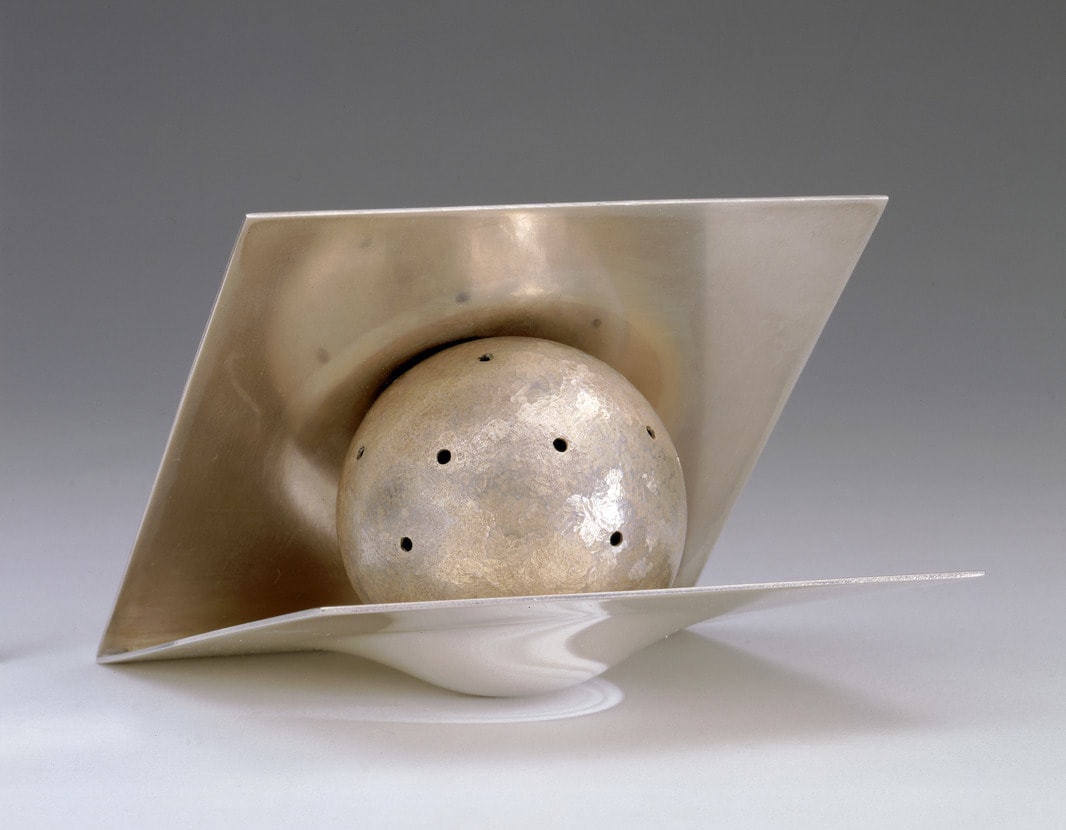
- Object Name:
- Spice Container
- Artist/Maker:
- Zelig Segal
- Bio:
- Israeli, 1933-2015
- Place Made:
- Jerusalem (Israel)
- Date:
- 1986
- Medium:
- Silver: cast and pierced
- Dimensions:
- 3 3/4 × 2 1/2 × 3 3/4 in. (9.5 × 6.4 × 9.5 cm)
- Credit Line:
- Purchase: Sanford C. Bernstein Foundation Fund
- Accession Number:
- 1995-72
Not On View
Israeli artist, designer, sculptor, and metalsmith Zelig Segal devoted his career to the creation of ritual objects. His ingenious approaches to ceremonial art are fresh, imaginative, and infused with deep understanding of Jewish tradition. Segal received his religious training in Jewish schools and studied metalsmithing and Judaica at Jerusalem's Bezalel Academy under Ludwig Wolpert and David Gumbel, two of the most influential artists in Jewish ceremonial design of the twentieth century. Segal graduated in 1954 and headed the school's Department of Gold and Silversmithing from 1964 to 1968.
For Segal, the design process was always a voyage of discovery, and he experimented freely. Simple, geometricized shapes and an aesthetic of refined simplicity characterized his work, which linked the modern design sensibilities with ancient Jewish traditions.
The juxtaposing of negative and positive elements is a recurring theme in Segal's work. The artist found myriad ways to express this concept- sometimes using the profiles of objects to create a plus/minus tension when they are placed near each other, and other times working with surface finishes to create differentiation. Segal's 1986 spice container employs both plain polished silver (the outer section) and textured silver (spice holder) to define the two principal elements of the piece. Spice containers are part of the ritual of havdalah, the ceremony that marks the end of the Sabbath. The sweet smell of the spice is meant to recall the beauty of the Sabbath. Segal's creation is not only a spice container but a sculptural work of art. He fashioned the work by "folding" a piece of polished silver in half to create an open wedge shape. He hammered out rounded protrusions in each of the sides so that the spice ball could be placed within this wedge and hang suspended. The irregular surface finish of the silver spice ball attracts the eye as its rough textures and polished areas pick up reflections of light. Like the silver ball within, the Segal spice container seems suspended between contemporary sculpture and modern packaging and yet recalls Jewish tradition.
For Segal, the design process was always a voyage of discovery, and he experimented freely. Simple, geometricized shapes and an aesthetic of refined simplicity characterized his work, which linked the modern design sensibilities with ancient Jewish traditions.
The juxtaposing of negative and positive elements is a recurring theme in Segal's work. The artist found myriad ways to express this concept- sometimes using the profiles of objects to create a plus/minus tension when they are placed near each other, and other times working with surface finishes to create differentiation. Segal's 1986 spice container employs both plain polished silver (the outer section) and textured silver (spice holder) to define the two principal elements of the piece. Spice containers are part of the ritual of havdalah, the ceremony that marks the end of the Sabbath. The sweet smell of the spice is meant to recall the beauty of the Sabbath. Segal's creation is not only a spice container but a sculptural work of art. He fashioned the work by "folding" a piece of polished silver in half to create an open wedge shape. He hammered out rounded protrusions in each of the sides so that the spice ball could be placed within this wedge and hang suspended. The irregular surface finish of the silver spice ball attracts the eye as its rough textures and polished areas pick up reflections of light. Like the silver ball within, the Segal spice container seems suspended between contemporary sculpture and modern packaging and yet recalls Jewish tradition.
Information may change as a result of ongoing research.